The forgotten story of the first ever game of Australian Rules football played in England
On Tuesday April 17, 1888, courtesy of that great innovation the electrical telegraph service, Australian newspapers including Melbourne’s The Age broke the news of a game of Australian Rules football being played in the mother country. Of course, the newspaper made sure to remind readers of the true origin of the local game:
VICTORIAN FOOTBALL MATCH IN LONDON.
LONDON, 16th April.
A football match was played on Saturday between Australians residing in London and Australians residing in Scotland. The game was played under the Victorian Association rules, and the teams were composed chiefly of medical students. The match resulted in a win for the Londoners.
On Saturday April 21, 1888, the Saturday newspaper The Leader, published the same report with some additional information:
[This match was arranged and brought to an issue through the energy of two players well known in Melbourne a few seasons back, Messrs. H. R. Power and W. K. Hughes who are studying medicine respectively at St. Mary’s and St. Bartholomew’s Hospitals, London. Australian footballers will be anxious to hear what impression their game made upon English spectators.]
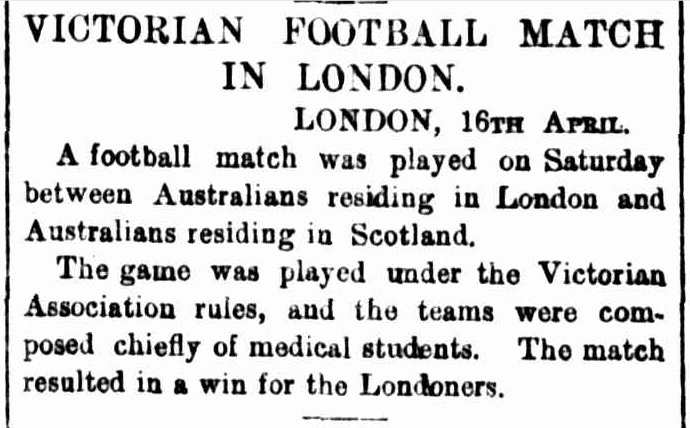
Over 130 years later, in this strange football-less time of coronavirus, I was curious to find out what impressions, if any, this historic game had made on the English
The first surprise I discovered in the British newspaper archives were advertisements taken out in Sporting Life promoting the game for three successive days (April 12,13, 14).
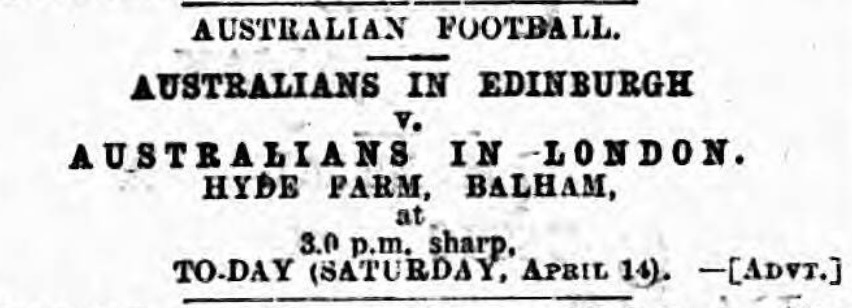
On the day of the match, April 14, 1888, Sporting Life also promoted the match in their editorial section:
Those admirers of the winter pastime who feel interested in the success of the English Football team in Australia may glad to know that exposition of “Football as she is played in Australia” may be witnessed this afternoon at Hyde Farm, Balham, between teams of Australians residing respectively in Edinburgh and London. Kick-off three prompt.
The English Football team mentioned was actually a British Isles Rugby team which extensively toured Australia and New Zealand in 1888 and even tried their hand at playing Australian Rules.
Hyde Farm, the venue for the match, was a medieval field in South London known for pig rearing and recreational grounds. By 1894 it had housed The London Baseball Park, where the London Thespians Baseball Club won the championship in 1894 in front of a crowd of thousands. The field’s days however were numbered and by the end of the 19th century it was turned into a nondescript housing estate.
A quick look at Google Maps confirmed that in the early 1990s I obliviously lived a very close 14 minute walk from Hyde Farm, the very location of this auspicious game, at 94 Kingswood Road, Brixton Hill.
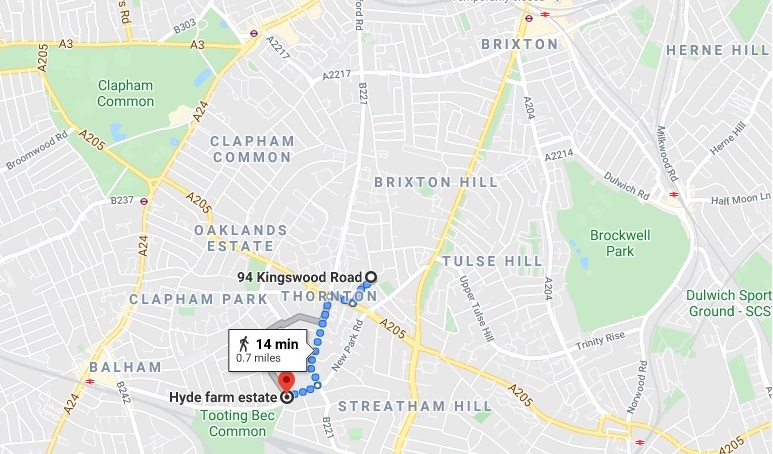
What of the game itself? Did anyone turn up to see this exhibition of Antipodean football? And what did they make of it?
On the Monday after the game, the London Evening Standard reported on the bizarre sight of hundreds of people wandering aimlessly around South London in search of the game:
Australian Football Match. — With a view of giving Londoners an opportunity of seeing a match under Australian rules, a game was arranged between the Colonists resident in London and Edinburgh. It was played on Saturday at Hyde Farm, Balham, in fine weather. The ground was very difficult to find, and many would-be spectators gave up the task as hopeless, few in the neighbourhood seeming to know anything about the match. However, the game proved of a most interesting character, and had it been decided on a more accessible ground there would doubtless have been a very large company. London, who had the wind at their backs, had much the better of the play in the first half, and scored four goals to none. Afterwards Edinburgh scored two goals, and London eventually won by four to two.
On a more positive note, news of the game and how it was played featured prominently in British newspapers that Monday.
For example, this is how it was reported in the Sheffield Independent:
AUSTRALIAN FOOTBALL.
LONDON AUSTRALIANS V. EDINBURGH AUSTRLIANS
Played at Balham. Result.—
LONDON…………………………. 4 goals.
EDINBURGH……………………… 2 goals.
A complete novelty in the way of sport was provided at Balham, a London suburb, on Saturday, in the shape of a football match under the code of rules authorized by the Victorian Football Association. It is not our purpose to describe the game at length, but it may well be mentioned that in the Colonial game (which is played sixteen a side) the competitors are allowed to pick up the ball, but have to bounce it every five yards – a rule which was not too strictly observed on Saturday. There is no offside and by taking the ball off the foot of another player on the same side a free kick is obtained. The men mark each other, or pair off, as at lacrosse, and there is no bar between the posts, a goal being obtained when the ball is sent between the uprights. A goal, however, is not allowed if the ball hit either post, or if one of the defending side touch it, this latter rule resembling that of the Rugby code. The above are some of the most striking distinctions in the game from either Rugby or Association football. It is, we should imagine, easy to learn, and yet presents plenty of opportunity for individual excellence and combined effort. The match was won by the London Australians by four goals to two. The match was won by London Australians by four goals to two. The Londoners, with the wind in their favour, scored all their points before half time. Moore kicking two goals and Manifold and Power one each. Reid and Pope obtained goals for Edinburgh in the second portion of the game.
Before moving to Britain, the two medical students who organised the match – H.R. Power and Wilfred Kent Hughes – played at a high level in the VFA for University and Essendon respectively. Considering matches in Victoria at the time consisted of twenty a side, the students did very well to get 32 expatriate players to take the field.
The logistical nightmare of securing players and a venue made evident in correspondence published a month after the match in Adelaide’s Evening Journal:
A football match is to be played tomorrow at Balham between Australians in England and Australians in Scotland. The English team is being organized by Mr. W. Kent Hughes. After the match the two teams and their friends are going to dine together at the Holborn Restaurant. I hear that, the Scotchmen are bringing down rather a strong lot, but that in consequence of a misunderstanding the match was off. The organizers of the English side have great difficulty in getting a really representative team together. Great difficulty has also been experienced in getting a good ground, club authorities having begun preparations for cricket. It is intended that the present match shall be the first of a series of contests.
Wilfred Hughes completed his studies in London in 1892. Unsurprisingly, Australian Rules football contests in London in subsequent years did not eventuate. Upon his return to Australia he resumed playing for Essendon, and was later president of the club.
By early June 1888, English newspapers with reports on the match had arrived in Australia. The Adelaide Observer reported on the trouble spectators had in finding the game:
A match between Australians in Edinburgh and Australians in London under the Australian rules of football took place last Saturday on a very uneven and out of-the-way piece of ground at Balham. The field where the game took place was so unknown that many people who had come down from London to see the match had to return disappointed, the rendezvous being undiscovered.
Meanwhile “Markwell” in Melbourne Saturday paper The Australasian ignored the bad news and focused on positives.
A daily London Journal of latest date to hand speaks in highly laudatory terms of the Australasian game of football in the report of a match played at Hyde Farm, Balham, on outskirts of London, by teams composed of Australian students from London and Edinburgh universities respectively. Great difficulty was experienced by the promoters of the match in obtaining the use of a ground and the game was eventually played under great disadvantages upon an exceedingly rough piece of common land. The journal referred to states:- “It was a great pity that so excellent a game should have been in a great measure spoilt by the rough ground, and it is to be hoped that if our colonial friends contemplate giving us a further illustration of their capital game they will find a better rendezvous. To spectators the game possesses great interest.” If a scratch game played under such unfavourable conditions evokes this eulogy, what would be said of such as exhibition as that we had the pleasure of witnessing last Saturday between Carlton and Geelong?
Melbourne newspapers in the 1880s were full of chatter on the global expansion of Australian Rules football. At the start of the 1888 football season, “Follower” while commending Messrs Power and Hughes on their missionary effort in England in The Leader, also exultantly claimed that “the Australasian game has now very nearly approached perfection.”
The game was ready to take on the world, if only the code’s administrators had shown the same dedication to the cause as that of Power and Hughes.
“Follower” had conveniently forgotten that four few years earlier “the father of Australian football”, Henry Harrison (Tom Wills’ cousin), travelled to England with the touring Australian Cricket Team. His mission, in his position as Vice President of the VFA, was to convert the English to the Australian game.
Thomas Power (no direct relation to H.R. Power), a well known football authority and former Carlton Football Club treasurer and secretary, recounted in The Sportsman in 1886:
When Mr. Harrison was at home (England) he tried to convince people of the superiority of the Victorian game, but it was like trying to force one’s head through a stone wall, because the English votaries of the game would not be convinced against their predilection in favour of their own.
Harrison wasn’t wrong. The North of England was in the throes of football fever. A few hundred miles up the road in Manchester, on the very same week this oddity of an Australian game was played on a London field, a seismic sporting announcement was made, the birth of a professional English Football League.
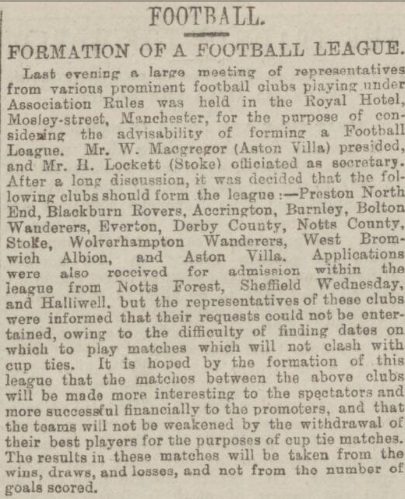
The Association game was about to take off. This football tsunami would soon swallow up what was previously an indifferent South of England and then the rest of the world.
Australian Rules football never stood a chance. Ambitious and costly plans to take a team to England, in the wake of the British Rugby team’s 1888 tour, never eventuated. The football arms race was settled.
It would take a World War, and the temporary migration of thousands of Australian men to fight on Europe’s Western Front, before another meaningful game of Australian Rules football was played on a London field in October 1916.
“For the first time in history, a truly Australian football game has been played before the English public by proved exponents,” Gerard Brosnan boldly announced in his expansive report of the famous game in The Winner.
By this time the original footballing pioneers of 1888 had been forgotten. They might not have been as expert, and their London playing field since converted to housing, but their attempt to bring footy to the London sporting public should be remembered. At least until this strange football-less time has passed.
EPILOGUE
In 1941, Dr. Wilfred Kent Hughes, one of the organisers of this historic, yet forgotten, match passed away at the age of 76. The following are from his obituaries in The Age and The Australasian.
The late Dr. Kent Hughes had a distinguished career as a surgeon, and played a prominent part in the civic life of Melbourne. He was a member of Melbourne City Council for a number of years, and as chairman of the parks and gardens committee was actively associated with development of many projects which resulted in beautification of the city. He was responsible for improvement to many of the city’s parks, gardens and thoroughfares, and for creation of children’s playgrounds. He also did valuable work for child welfare as a member of the health committee of the council. For many years he was consulting surgeon to the Children’s Hospital, and was associated with Royal Melbourne and St. Vincent’s hospitals as senior laryngologist and orthopaedic surgeon respectively. He served in the last war as a major with the A.A.M.C., and in 1917 was surgeon in chief to the Anglo-Russian hospitals in Russia. Dr. Kent Hughes wrote a number of works on medical and surgical subjects. In his younger days he was a prominent athlete, being second in the half-mile world championship in 1888.
Wilfred Kent Hughes was at Melbourne Grammar School from 1874 to 1881, and was head of the school in his last year. He was also senior prefect, and thus had the double honour “head” and “captain.” He was in the cricket, football, and athletic teams. Leaving school, he began his medical course at the Melburne University before going to England, where he graduated. MRCS (England), LRCB (London), and MB (London). He was the half-mile champion of the United Hospitals, London, from 1886 to 1892, 3 miles in 1886, and one mile in 1887-1892, and on his return to Australia won the half-mile championship of Victoria in 1893. He was a leading footballer, playing with Essendon for several years, and was later president of the club.
His eldest son, W. S. Kent Hughes, was also captain of Melbourne Grammar School, a champion athlete, Rhodes Scholar, and Oxford half-blue for athletics and lacrosse, and was 440 hurdles champion of England. He represented Australia at the Olympic Games at Antwerp in 1920. He has been a member of the Legislative Assembly since 1927, and was Minister for Railways in 1934. He was on active service throughout the Great War, 1914-1918, leaving school to enlist, and was awarded the Military Cross. He is now on active service in the Far East.
His eldest son, Sir Wilfrid Selwyn “Billy” Kent” Hughes was captured in the fall of Singapore in February 1942. For three and a half years he was a Japanese prisoner of war in Changi, Taiwan and Manchuria. He held the federal seat of Chisholm for the Liberal Party from 1949 until his death in 1970, and was chairman of the 1956 Melbourne Olympic Games organizing committee.

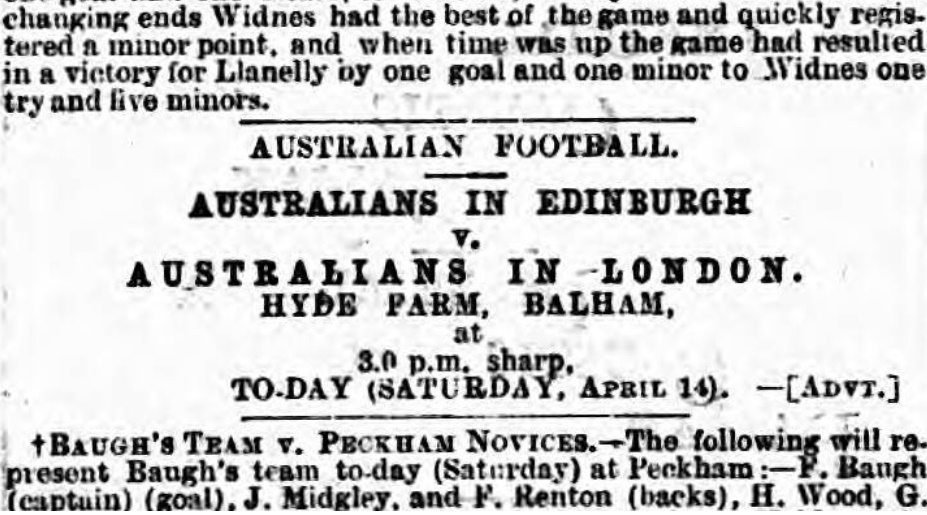

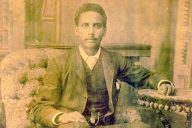
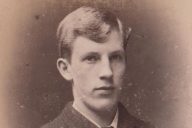
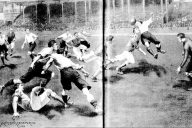











Another fascinating story, Athas. I loved the idea of lost souls wandering all over south London looking for the ground. Nearer to home, the other day I went for an exercise walk in Bannockburn, but when I set off on the return from my furthest point I had to pull out the map on my phone to help me find my way back. The place has grown so much recently.
Did you ever pursue Cec Mullen’s notion that there was an Aussie Rules league in Glasgow during the First World War? Least I think that is where the idea came from. Since he was so unreliable, I made only a desultory attempt to check it out. Given the number of Australians in the UK during the war it is not a completely implausible idea, though unlikely.
Roy, in 2003 I published a fully researched and illustrated book on this Balham football match (and the related 19 Victorian Rules games played by the British Rugby team which toured the Australian colonies in 1888). It is not surprising that Edinburgh fielded a team at Balham as there were so many Australian medical students in ‘Auld Reekie’ that they established the plush Edinburgh Australasians Club at 12 Archibald Place. During this period their cricket team featured Australian Test players and prominent VFA footballers such as RH Morrison, AB Timms and GF Reed (Geelong), C Campbell, A Kearney and J Adams (Essendon) and many others. GF Reed played in the Balham match in which Edinburgh had to ‘lend’ London FW Wingrove the Victorian cricketer. You can see the cover of my book ‘Football’s Forgotten Tour’ on the Internet. The English cricketer Arthur Shrewsbury who organised the Rugby tour of Australia tried to arrange for a VFA team to travel to Britain to play a series of Victorian Rules exhibition games against the Edinburgh Australasians but the VFA didn’t back the scheme. Kind regards – John.
Hi John, thanks for your comment. In the article I make no claim to discovering the game. I was aware the game was known to historians and that it was even written about. However, there is no online content about this game. Zero, nothing, nada. This is why I undertook this little exercise during this footyless time. Kind regards, Athas.
Hi Athas, thank you for your reply and your welcome online article. Coincidentally ?, the Balham match occurred while the 1888 British Rugby team played a series of 19 Australian Rules matches in Vic, SA and NSW. On 10 July they beat Port Adelaide at Adelaide Oval, 8 8 to 7 8. Among the 6 Scottish players in the party was Edinburgh University’s Dr John Smith, the first Scot to score 3 goals against England in Association football. He also represented his country in Rugby and Australian Rules! Best wishes, John
Hi John, that is wonderful. What a brilliant individual sporting achievement by the doctor. As I was researching my piece I found a number of articles about that historic 1888 tour and how it has also inspired books. Alas there was little about the Balham game for people to access online. A friend of mine who played Aussie Rules in Edinburgh has now sent this article to his mates in Scotland. It has also been shared by expats living in London who are associated with North London Lions. So it make the effort worthwhile. Thanks again for your words. Athas
Glad to see your story was picked up by Antony Colangelo in the Sunday Age today.
Hi Roy, great to hear from you and thanks for the lovely words.
And yes, Anthony did a terrific job in The Age reporting on this story and getting it published in print in The Sunday Age.
https://www.theage.com.au/sport/afl/played-in-1888-on-a-pig-farm-tales-of-first-aussie-rules-game-in-england-emerge-20200527-p54wt0.html
Terrific research and writing, Athas.
Thanks Adam. Much appreciated.
To John Williamson
Thanks for your comment, John. Of course, I know and read your book. My copy is now with all the rest of my soccer stuff in the MCC Library, so I can’t pick it off my shelf at home as I used to do. I need to get back to it again for a piece on the Scottish influence on the football codes in Australia, which I was planning to deliver to the 4th International Football History Conference at Easter Road this coming weekend. That like so much else has been virused out. I grew up with the Famous Five, not Enid Blyton’s but Smith, Johnstone, Reilly, Turnbull and Ormond.
This notion of unknown stories always bugs me as an historian. We all stand on the shoulders of giants, and it is very often the case that someone has been there before us. On the other hand, there is a generation growing up who, I fear, may decide that if it is not on Google it is not knowledge, so reminders of real books never goes wrong. And real stories of our past. Athas does a great service with Shootfarken, both for what he writes himself and what he publishes from other squirrels, who keep finding nuts in strange places.